
This is Part 4 of a 6 Part series focused on Washington. We will spend one very busy week traversing a wide loop around the scenic state, hitting three gorgeous National Parks (Mount Rainier, Olympic, and North Cascades); visiting the fun Cascade Loop towns of Winthrop, Chelan, and Leavenworth; viewing a waterfall twice the height of Niagara; and even riding a car ferry across the Puget Sound to spend some time in Seattle. In Part 4, we will stop off at the famed Snoqualmie Falls en route to the highlight of our trip, Mount Rainier National Park. Once there, we'll take a gondola to a picture-perfect view of the park's namesake, go on several unique hikes highlighting the snowy landscape, and spend a night in the historic Paradise Inn.
Today is the day of our trip I've anticipated the most since I began planning this vacation--we're going to see Mount Rainier! Standing at an imposing 14,410 feet above sea level, this volcanic behemoth is visible from hundreds of miles away. Its famed glaciated peak adorns many a Washington state guidebook, and today, we're finally going to see the real thing.
We're currenty in the town of Leavenworth, though, about three hours northeast of Mount Rainier National Park; so we have a bit of a drive ahead of us still. We're also making a slight detour en route to see the towering Snoqualmie Falls. It's about 7:30am currently, and we've just finished up breakfast at our hotel and are getting ready to depart. We have about a two hour drive to Snoqualmie Falls from here, but the detour only adds about 30 minutes to our route; so it's well worth a stop.

At 268 feet tall, Snoqualmie Falls is more than twice the height of Niagara. It is the most visited waterfall in Washington state. The falls are attractive on their own merits, but they are also famous for their feature shots in the 90s television mystery show, Twin Peaks. That connection doesn't really mean much to me, but I don't want to miss these scenic falls when we'll be so nearby.
When we arrive at Snoqualmie Falls, we park at the lot across the street* and walk over the short sky bridge to take in the two upper viewpoints of the waterfall. The thundering falls form a double cascade as they tumble over the granite cliff and down to the pool below. It is one of the more unique looking waterfalls I've visited.
*Tip: The parking lot across the street from the falls is free. There is a short skybridge that takes you from there to the viewpoints over the falls. If you park in the lot that is (slightly) closer to the falls, it costs $7. It is literally only a few extra steps to park in the free lot. If you don't have a mobility issue, save your money. You can find a diagram of the falls' parking lots here.
We take in the falls from both of the picturesque upper viewpoints and decide to forego going down to the bottom of the falls for another perspective. We have a very busy day planned, and we need to keep moving to stay on schedule. It would be nice to visit the site a bit later in the morning or at midday since the sun hasn’t fully illuminated the cascade at this hour, but it’s still quite beautiful even in a bit of a shadow.
As we head back toward our car, we pass the Salish Lodge & Spa* perched above the waterfall. Offering two restaurants, a spa and a gift shop, it like a picture-perfect spot to take in the surrounding scenery from while enjoying a meal. Maybe next time--for now, though, we need to be off to our next stop.
*Tip: If you have plans as the Salish Lodge & Spa, they offer free valet parking for guests and customers.
From Snoqualmie, it’s about an hour and a half to our next destination—the Crystal Mountain Mount Rainier Gondola. Crystal Mountain Resort is a winter ski resort with what appears to be some awesome hills for an advanced skier, but in the summer, the main attraction here is the Gondola that takes you 2,400 vertical feet up to a viewpoint over Mount Rainier and the Cascade Range. Also at the top sits the Summit House Restaurant, Washington’s highest elevation restaurant at 6,972 feet.

When we arrive at the Gondola* parking area, we secure our belongings, grab a jacket (it can get cold up there), and set off in searching of the ticket counter. The cost is a bit hefty; for the two of us, I spend just under $100 for round-trip tickets with tax, but you can save money by reserving ahead. Tickets are non-refundable, though, and I didn’t want to risk having a foggy day (in which case we would have skipped this stop-off). By making the decision to get our tickets today--after seeing the gorgeous blue skies--I know this is a trip worth taking.
*Note: The resort/gondola entrance are about 6 miles off of the main road along a fairly windy route; drive carefully. Each enclosed gondola car can hold up to 8 people. In summer, the gondola runs from 10am-5pm.
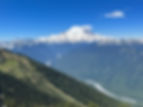
The Gondola ride take about 12 minutes each way. There is only one couple ahead of us in line, so we are quickly loaded up in our own car and on our way up the mountain. I don't particularly love heights, so being suspended on a cable line over a mountain isn't exactly my cup of tea, but the views throughout the ride are breathtaking and takes my mind off of the vertical distance between our gondola car and the mountainside below
When we disembark at the mountaintop, I am awestruck by the sudden emergence of the mammoth Mount Rainier directly in front of me. We decide to walk around first, taking in the surrounding scenery, and then we settle into one of the comfortable Adirondack seats set up along the perimeter of the mountaintop. We just take extra care to stay well back from the ledge! It's nice to relax for a minute and just enjoy the gorgeous view of Mount Rainier and the other snow-capped mountains surrounding us.
The wind coming off of Mount Rainier, even in July, is chilly. It's as if you can feel the icy breath of the glaciers on your cheeks every time the wind picks up a bit. Luckily, today the wind speed is fairly low, and it’s generally pleasant up here, even with the surrounding snow.

Before we depart, I decide I need something to carry me over to dinner tonight. I'm hungry, and the Summit House Restaurant* is most definitely calling my name. Unfortunately, we don't have the time for a sit-down restaurant right now. So, I get a hot pretzel from the stand set up outside. I’m a little shocked at the price tag ($15), but I guess we’re paying for the scenery and the effort involved in lugging food to the top of a mountain. Taking my pretzel for the descending gondola, we enjoy our snack with a five-star view.
* Note: The Summit House Restaurant is the highest elevation restaurant in Washington state. All seating is first come, first serve; they do not take reservations. There is some wonderful outdoor seating overlooking Mount Rainier, as well as an indoor dining room.
Back at the car, we head toward the Sunrise section of Mount Rainier National Park. Mount Rainier National Park is separated into five sections with the mountain at the center: Sunrise, Paradise, Longmire, Ohanapecosh, and Carbon River/Mowich with four main entrances: Carbon River, Nisqually (for Longmire and Paradise), Stevens Canyon (for Ohanapecosh), and White River (for Sunrise). Of those, only two entrances (Nisqually and Carbon River) are open year-round. The Carbon River section of the park is less often visited due to its geographically separated location in relation to the other sites. On this trip, we are also skipping a visit to that section due to time constraints.
Map of Mount Rainier National Park

Underlying Map Source: nps.gov/mora (you can find the full-sized park map link here)
The Sunrise section of the park is only open from early July to September, opening and closing dates are weather dependent. When I planned this trip originally, I had that in mind when selecting my July dates and crossed my fingers that there wouldn't be a late snowfall this year to interrupt my plans. Luckily, the entrance is open for the season, but it's packed; the gate to get into this section of the park is backed up currently, operating a one car in, one car out queue. It’s a Friday afternoon, so I can certainly understand why. It takes us about 15 minutes for us to get through the entrance booth, which isn't too bad; it being a bit later in the afternoon at this point definitely helps. Once it's our turn to enter, we flash our Annual National Park Pass to the park ranger, collect a park map, and head inside.
*Note: The "America the Beautiful" National Park Annual Pass is a great value if you are visiting several parks. The pass is $80 and valid for 12 months from the month of purchase (expiring the last day of that month). With the pass, you get access to more than 2,000 recreation areas. "Each Annual Pass can have up to two owners and admits pass owner(s) and passengers in a non-commercial vehicle at per-vehicle sites and a pass owner plus 3 adults (not to exceed 4 adults), where per-person fees are charged (children under 16 are always admitted free)." The following are entitled to FREE annual passes: Current U.S. Military members and their dependents, U.S. veterans, Gold Star Families, and U.S. 4th graders. U.S. citizens/permanent residents with permanent disabilities are entitled to free lifetime passes. Additionally, the parks offer discounted senior citizen passes, both annual ($20) and lifetime ($80). More information on all of these pass options can be found here. For specifics/FAQs on the Annual Pass (or to purchase it ahead of time), you can find more information here.
Photos: Park Entrance (left); Sunrise Point (right)
Sunrise Point is the highest point you can get to by car in the park—6,400 feet. The road leading to the point is approximately 15 miles long from the turnoff for the White River entrance. My husband is surprised how long the road is to get to the Sunrise Visitor Center (the end of the road and the start of the hike we plan to do). I think it feels a bit longer than it is due to the plethora of switchbacks along the route that require careful and relatively slow driving in order to navigate safely.
About 2.7 miles before the Visitor Center is Sunrise Point, with a parking lot framed between a hairpin bend in the road. We pull into the lot to take in the view of Mount Rainier--all 14,410 feet of it--and the second highest peak in Washington State, Mount Adams (12,280 feet). I’m so happy that we lucked out with a clear day today. There are a few wispy clouds framing the mountain, but they only add to the gorgeous scenery.
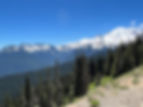
The view from Sunrise Point is nice, but the parking lot sits in the middle of our view of Mount Rainier. However, the surrounding mountains from the viewpoints encircling the parking area are still gorgeous. We walk around a bit and then hop back into the car to drive the short distance up to the Visitor Center, the departure point for our hike to the Mount Fremont Fire Lookout.

The Mount Fremont Fire Lookout Trail is a little under 6 mile out and back trail rated easy to moderate. I’ve done my research, and it does not appear that the hike will have any dramatic drop-offs (we are not a fan of walking on cliff-sides), but it will have a steady (but hopefully not overwhelming) elevation gain. The Visitor Center is at an elevation of 6,400, and we will have about a 900 foot elevation gain on our hike, taking us even higher than we were on the gondola earlier.
Photos: Start of Mount Fremont Fire Lookout Trail (left); Mount Rainier (right)
The hike departs from a short paved section right between the Sunrise Visitor Center and the Sunrise Day Lodge, before ascending uphill. The beginning of the hike follows the same trail as the Sourdough Ridge trail out to Frozen Lake. The view is already gorgeous, with an incredible view of Mount Rainier alongside us as we set off.
We have our hiking poles, and I’m very glad of it as we hit the first patch of snow on the trail. It’s mid-July, but there is still snow blanketing sections of the trail. It’s nothing we can't navigate, but it is slippery and requires going a bit slower than our usual hiking pace when we hit those patches. The trail is well marked at each junction, and we have no trouble ascertaining which way we’re supposed to be going when we run into the few turnoffs along our route.
Photos: Mount Rainier From The Trail (left); Frozen Lake (right)
We move at a fairly steady clip along the trail--minus the snowy patches--enjoying the progressively better and better views of Mount Rainier and the surrounding landscape as we slowly ascend upwards along our route. About 1.3 miles in, we come to Frozen Lake. A lot of people appear to make this their hike turnaround point. I don’t think the lake is anything particularly spectacular to look at, but the views of Mount Rainier are wonderful.
Other gorgeous trails, like the Wonderland Trail and Northern Loop Trail, head in the opposite direction from this point, and my husband comments that he would like to explore that way if we had more time. The appeal to head toward Mount Rainier is great, but those are rigorous multi-day hikes. Today, we are attempting something more bite-sized!
From frozen lake, the trail steadily climbs upward, sometimes crossing a small section of snow, sometimes dusty gravel, and sometimes much larger (and sharper) rocks. In the latter sections, we have to pick our way through the trail a bit more carefully. It never gets beyond moderately difficult, though. I mention a few times that we don’t per se need to complete the entire thing, but we’re enjoying the ever improving views of Mount Rainier and the surrounding mountain range, and it’s a fun challenge to get to the lookout tower. We can see the tower well in the distance before we reach it—it certainly looks closer than it actually is--but it’s encouraging to be able to see our destination.
We continue along the barren trail cut into the rocky mountainside, and not too far from the end of the trail, we come to a rock overlooking the trail that looks like a face; so we stop for a moment to take a picture. It’s a fun, quick reset. As we continue up, the last section has quite a bit of larger, uneven rocks strewn across the trail, and we pick our way carefully over them. Soon, though, we are at the top! We come to a stop at the highest point, overlooking the lookout tower below us. The view from up here is incredible—it looks fake! Once again, I’m so happy that we have a clear day from which to enjoy this spectacular sight.
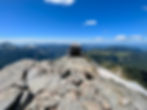
A hiker offers to take our picture for us, and I’m happy she does. If not, we may not have even thought to get a commemorative shot of our accomplishment. We pause to just enjoy the panoramic view surrounding us. It took us about 1:25 to get up here, including plenty of quick photo stops along the way, so we’re moving about equivalent with the lower range of the estimated hiking length—2.5 to 5 hours. I’d been hoping we wouldn’t take more than 4 hours max, so we are well ahead of my guesstimate.
Heading downhill, we have Mount Rainier directly in front of us—causing a few extra photo stops, but we move at a fairly rapid clip. The descent is not so steep as to impeded our pace. While I prefer loop hikes, the scenery in front of us from each direction on this hike is both dramatic and different enough that we don't tend to find the views repetitive.

It's also easy for Mount Rainier to keep our interest. This massive mountain is different from every angle along our hike. The cloud cover is constantly shifting and changing. It's simply mesmerizing to watch this perdurable giant constantly fluctuating in appearance.
We scramble over the last few snowy sections back near the beginning of the trail, and come down to the Visitor Center. I look at my phone, and the total hike, with stops, took us 2 hours and 28 minutes to complete—right in line with the lower time estimate. (I will warn those attempting the hike that while we love to take a quick photo as we go, we walk relatively quickly as we hike.)
Our visit to Sunrise at an end, we return to our car and reverse direction back down the side of the mountain. My husband is surprised that we can’t get to the Paradise Section of the Park from here, but I quickly run through the layout of Mount Rainier National Park. In summer, the Paradise and Longmire sections of the park (Nisqually entrance) are connected to the Ohanapecosh (Stevens Canyon entrance) section by Stevens Canyon Road. In winter, there is no thoroughfare between the two areas as a section of Stevens Canyon Road closes. However, portions of the park are also currently undergoing construction. As a result, Stevens Canyon Road has remained closed with no connecting route between the two park entrances.
However, we have lucked out BIG TIME today! Stevens Canyon Road literally opened at 8am this morning for the first time all season, and it’s only open from 8am Friday mornings until 6am Monday mornings for the remainder of the season due to ongoing roadwork. If the road wasn’t open during our visit, it would take us another two hours to traverse around the park's perimeter to the Nisqually entrance and down to the Paradise Inn at the Paradise section of park, where we are sleeping tonight.

Originally, I had booked the Cowlitz River Lodge in Packwood for our visit to the park. Packwood is just south of Sunrise and the park’s Stevens Canyon Entrance. It's a small town with a brewery and some restaurants that makes a good home base from which to visit the Sunrise and Stevens Canyon area of the park. I’d planned to hit the Paradise side of the park the next day since we had to go all the way around to the Nisqually entrance to visit that area. However, a series of both unfortunate and fortunate events have led to our change in dates and lodgings.
When I had to rebook our trip due to my getting sick prior to our original departure, I had to modify our itinerary. That left us in the area on a Friday night, and EVERYWHERE I looked was full. The only thing I could find was a last minute opening in the Paradise Inn inside of the park. It was a historic double room with a sink that utilized shared bathroom facilities. For a night, it seemed more than adequate, but getting to the Inn would have been a nightmare from the Sunrise area of the park if Stevens Canyon Road was still closed in the center—not allowing thru traffic to Paradise.
Happily, the stars have aligned for the night, and the road is open. I’m a bit leery about what kind of delays we will encounter--and if my information, directly from the NPS website, is accurate--but we cross our fingers and hope for the best as we turn into the Stevens Canyon Road entrance. The gate is no longer manned at this hour (around 5:30pm), so there’s no one to ask.
We traverse the switchback park road, passing some construction areas and crossing over some rough sections of concrete (it appears ready for re-paving), but the road remains open throughout our drive. When we get to about 5 miles before the Paradise Inn area, I ask my husband if he thinks we have time for one more hike. He looks at me as if I’m a bit crazy, but he says yes. It’s around 6pm, and it should be pretty quick. Our dinner reservation is for 7:45pm, so we should be able to make it work. We park the car at the trailhead for the Bench Lake and Snow Lake hikes.

Bench Lake is only 0.7 miles each way (approximately 1.5 miles round trip), and it’s supposed to have gorgeous views of Mount Rainier. Along the trail, I’ve read we will encounter a meadow full of wildflowers, and it sound like a good, easy(ish) hike to take in a different side of the park. Beyond that, another 0.5 miles takes you to Snow Lake, but I’m not as keen to see that as I am to see Bench Lake.
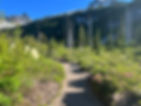
The trail climbs up a series of stairs cut into the hillside for the first part of the hike and then levels out at the meadow. There are some wildflowers blooming, but we both remark that in a few more weeks, this meadow will probably be spectacular. It’s not peak wildflower season quite yet—even in mid-July!
After the meadow, we cross through a flat section and then come to a downward portion of the trail and have to travers another similar stair-like area. When we come to the sign for Bench Lake, it appears to point straight into the brush. There are two small trails cut into the bushes on the side of the trail, and we try both with pretty much no luck. At the end of each trail is the lake, but you can’t see much of anything from where the trail ends. The gorgeous view I was expecting of Mount Rainier is pretty much blocked by all of the surrounding foliage. We remark that maybe the lake level is still too high from all of the melting snow to be able to get close enough to a shoreline. So much for that!

When we come out of the bushes, I remark to my husband that maybe we should try and do the last 0.5 mile stretch up to Snow Lake. It will add a mile total to our hike, make it a 2.5 mile hike instead of a quick 1.5 miles, but I feel like we’re all the way out here now and haven’t really “seen much.” So, he reluctantly agrees.
The next 0.5 miles of the hike is a lot of upward climbing. We do get a few great glimpses of Mount Rainier behind us, but we’ve seen a lot of it today already. Snow Lake is called Snow Lake for a reason, and soon, we find ourselves scrambling over large sections of snow still on the trail. I see one or two people wipe out during our hike. We each grabbed one hiking pole to bring with us last minute, and thank goodness we did, it definitely helps to steady us during the hike.
We also have to travel over some running water, once on a log positioned in the middle of the water. I’m a little concerned that I’m going to fall off and end up in the water, but I make it across. This is certainly more of an adventure than I had planned for us this late in the day!
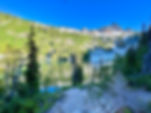
Finally, we emerge near Snow Lake. We’ve been warned by fellow hikers coming back from the lake that going down to the lake-front is quite muddy. Instead, they recommend turning toward the campground at the lake to find a decent overlook from there. We quickly encounter the viewpoint. It’s nice, but it doesn’t come anywhere close to the Rainy Lake viewpoint we had in North Cascades National Park—and that hike was a lot less strenuous!
We reverse course and work our way back through all of the snow, over the river and through the woods. We repeat the reverse ups and downs of the trail, back through the meadow—the sun is shining beautifully on Mount Rainier, it’s a shame we couldn’t see it from Bench Lake—and back down to our car. We manage to do the total hike in just under an hour (again, we move relatively quickly, my research says the hike takes 1.5-2.5 hours) and are back on our way to the Paradise Inn at a little before 7pm.

The Paradise Inn isn’t too far from the hiking trail (about 5 miles), and we arrive a few minutes later to check-in. Our room is on the second floor of the lodge, so we carry our bags up the steps and down the hall to where it is located. The room is tiny, but it’s more than fine for a night. We’re both exhausted and a bit dirty from all of our muddy hiking, but we clean up a bit with the help of the room's sink and head down to dinner. We’re both starving and we have a reservation in a few minutes; we can shower after we eat.
Downstairs, we make a quick stop in the gift shop so I can buy a Christmas Ornament (I collect them at most of our travel destinations) and then head over to the dining room to check in for our reservation this evening. There is a piano player in the lobby (typically 4pm-8pm), and we stop to listen for a minute while we wait for our table to be readied. It’s a fun, peaceful atmosphere I often find in National Park Lodges at the end of the day. Everyone is done with their busy day of rushing around, hiking, and taking in all of the spectacular sights, and now they are ready to sit down, relax a bit, and reflect on their day. Piano music provides the perfect accompaniment.
Soon, our table is ready, and we quickly select our dinner choices. We’re famished. We also each get a local brew to wash it down. My husband chooses a beer on tap, and I try a Kaloch beer—very refreshing after a looong day. For dinner, we decide to share a Salmon BLT and a Wagyu Cheeseburger. Both meals come with French fries as the side. The menu isn’t large (there are about 4 entrees and 3 salads), but we are more than fine with anything edible at this point!
Our server apologizes that dinner will be served on paper goods this evening, apparently the dishwasher is broken. We’re not exactly worried about how fancy our food comes out, so we tell her not to remotely worry about it. Our food takes a bit as the kitchen is backed up with an influx of tables, but we again tell her not to stress.
We strike up a conversation while we're waiting, and she tells us that she is from Florida. We always find it interesting discovering how the various park employees ended up there. She says she originally accepted a job at Yosemite, but the Mount Rainier opening came up about two weeks before her start date, and she decided it sounded like the perfect spot. She certainly couldn’t get any farther from Florida weather here!
When our meals arrive, we polish them off very quickly. We are one of the last tables in the dining room (the restaurant closes at 8pm), and our server offers us dessert on the house to make up for the wait we've had for our food. It's not necessary but much appreciated. She soon arrives with a slice of warm blackberry pie topped with creamy vanilla ice cream. It is absolutely delicious, and the perfect cap to a long day!
After dinner, we head up to our room and don the room’s supplied bathrobes and disposable shoes to shower down the hallway. It feels very good to clean off the day’s grime. When booking the room here, I wasn't sure about how the shared bathroom facilities would work out, but all we need this evening is a quick shower, and we’ll be back on the road tomorrow. The setup is more than sufficient for a quick stopover.
After our showers, we decide to call it a night. The room is a little warm (there’s no air conditioning at the lodge—or in much of Washington State honesty), but the room has a provided fan; so, we flip that on and get ready for bed. It’s been a very eventful day, and we cannot wait for a good night's sleep!

In the morning, we wake bright and early at 5:30am. It's our fourth full day of vacation, and we have probably the longest day of our trip ahead of us (in terms of driving); so we want to get an early start. The quick service counter in the park opens at 6am. We plan to get up, ready, check-out, and hit that on our way out for some caffeine and a light breakfast.
The lodge is still fairly quiet this early, but there is some activity. Like us, many hikers prefer to get an early start to their day. After a quick fuel-up, we’re off, too. This morning, I have two hikes planned for prior to our departure, but one isn’t going to be worth it if the cloud cover doesn't lift.

Our first hike leaves from right next to where our car is parked; so, we take our luggage to the car to pack it into the trunk first. As we exit the lodge, we take in the scenery. Currently, we can’t even see Mount Rainier through the mist blanketing the mountainside. The cloud cover is rather scenic across certain parts of the landscape--it's just a shame it's also blocking Mount Rainier. The moon is still visible in the sky this morning, which adds to the early feel to the day.
The Myrtle Falls Hike is a paved trail that departs from the Upper Paradise Parking Lot (where we are currently). The hike is only 0.5 miles (one way); so I definitely want to check it out. This trail is also the start to the Skyline Trail—a popular 6.2 mile (strenuous) hike. It’s one of the most popular in the park, but I chose the hike we did yesterday over Skyline, and we didn’t really have time for both. The snow cover on the Skyline Trail also deterred me. Maybe if it was August I would have been more likely to consider it.
Even just walking the short distance out to Myrtle Falls is a feat! The trail is paved, but in quite a few sections, it is entirely covered in snow and ice. More than once I think I am going to fall. We didn’t think to bring our hiking poles for a paved one mile round-trip walk, but we definitely could have used them!

We reach the falls viewpoint without incident, though. It’s quite a pretty waterfall--and very loud, fed by all of the snowmelt coming from above us. The waterfall is 72 feet tall, but it is a bit more dramatic in the way it drops into the chasm below us. After viewing Myrtle Falls, we reverse direction and hike back the way we came. We can see up to the snow-covered Skyline Trail; I cannot imaging doing that hike right now, even with crampons on our shoes and snow-basket adorned hiking poles it would be a difficult feat.
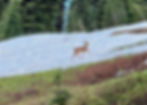
When we get back to the parking lot, Mount Rainier is still obscured by cloud cover; so, we decide to forego the Nisqually Vista Hike. It's close--it departs from the Lower Paradise parking lot--and it’s only a 1.2 mile easy loop, but there’s not much sense taking the hike if we can’t see the views that make it famous. Plus, after our last experience in the snow, we decide that “paved and easy” may be a relative term here.
With that decision made, we take the car back to the main park thoroughfare and turn toward the Nisqually Entrance to exit Mount Rainier National Park. It still takes us a bit to get out of the park; it's about 16 miles miles to the exit, and the road has a lot of twists and turns, but we're headed in the right direction (literally). Soon enough, we'll be back on the open road headed to our next destination—Olympic National Park.
Part 5: Olympic National Park is coming soon!
Credit for Some of the Featured Photos: Kyle Perkins

















































































